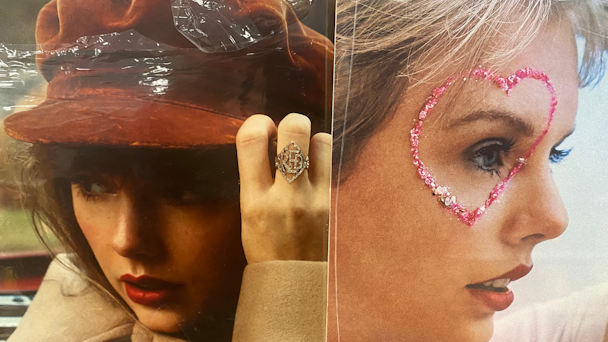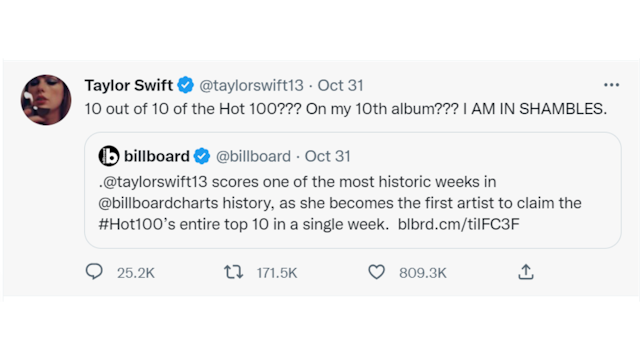Three surprising secrets behind Taylor Swift's brand success
Taylor Swift has a clear marketing playbook refined over her 15-year career. Salesforce strategy exec Martin Kihn reveals its secrets.

Taylor Swift has a way of breaking things: records, superlatives, hearts, and even – when she committed the previously inconceivable magic of occupying all 10 spots on the Billboard Top 10 with tracks from her 10th album Midnights – herself. See below.

She also broke Ticketmaster, apparently startled by demand for the 2.5 million tickets available for her 52-city 'The Eras' tour, her first since 2018.
"It's a function of Taylor Swift," said the CEO of the largest shareholder in Live Nation/Ticketmaster's on CNBC. "We had 14 million people hit the site, including bots." Even non-humans love Swift.
What's her secret? After Midnight dropped at, of course, midnight on October 21st, Swift became the most-streamed artist with the most-streamed album in a day on Spotify, breaking records set by her own Red (Taylor's Version) and 2020's folklore.
By now, it's clear Taylor Swift's only rival is herself.
"Taylor Swift is nearly unimpeachable as a human, role model and brand," Aaron Kwittken, Chief Executive of the PRophet, told The Drum recently.
As a brand – setting aside her artistry for a moment – Taylor Swift is a global phenomenon. Capital One, Target, Starbucks, Keds, CoverGirl, Diet Coke, Apple, Comcast, American Greetings – just a partial list of partners who have contributed to her estimated $400 million net worth in recent years.
Make no mistake; she's a marketing engine. And it turns out brand Taylor Swift has a definite playbook, refined over her 15-year career. She still has a lot to teach marketers.
Advertisement
1. Be an Anti-Brand
The first single from the 13-song Midnights was called "Anti-Hero," which Swift claims is about her "insecurities." (Remember that number 13: it's important.) In many ways, Taylor Swift is an Anti-Brand.
Traditional branding calls for a definite identity, promise and voice. It requires research-driven lines in the "brand space." But Taylor Swift doesn't have these things – she's more of a "Blank Space" on which any of us, no matter how different, can see anything we need to see, especially ourselves.
Earlier this month, Midnights sponsor Capital One revealed two spots for the World Series called "Multiple Taylors," featuring versions of Swift from 1989, Speak Now and others. It recalled the cryptic video for her song "Look What You Made Me Do," from Reputation, unleashed at the 2017 MTV Video Music Awards, which featured 15 versions of Swift, from the Red ringmaster to the stunned victim of Kanye's notorious trophy-snatching.
She dared to ask us: "Who is the real Taylor Swift?" And the answer: We all are, pick the one you want.
She's an oddly malleable brand, ideally suited to an age of creators, remixes and memes. It makes sense that there are multiple versions of two of her albums, with at least four more to come. Another celebrity, Ryan Adams, famously rerecorded her entire 1989 himself.
And then there are the lookalikes: it's possible to become TikTok famous just for looking a little bit like Swift. And the oddly Teflonish quality: famous people who seem to want to feud with Swift somehow end up fading away (like Katy Perry) or on stage at one of her shows singing a duet (like Hayley Kiyoko), best friends forever.
Sociologist Emile Durkheim talked about totems as supernatural objects within which tribes can see themselves. Brands like Taylor Swift are totems for the age of TikTok.
Advertisement
2. Make your fans work
It's not easy being a fan of Taylor Swift; just ask us. Between buying $75 pajamas at her Official Store, waiting on virtual lines that break, and pre-ordering 13 copies of the expanded 20-song Midnights (3am Edition), there's barely time to decipher all the clues she's left in her TikToks, lyrics and Insta captions.
Mainstream fans might not know it, but Swift has long embedded Baroque ciphers into her marketing materials. She does this to encourage social media action, conversation, digital engagement – and of course to repay our attention.
Swift's code-work started early. Her first album, Taylor Swift, released in 2006 when she was 16, featured liner notes with random capital letters, embedding messages like "Date Nice Boys." She told the Washington Post: "That's how it started, and my fans and I have since descended into color coding, numerology, word searches, elaborate hints, and Easter eggs."
Examples abound – so many, in fact, that at least one commentator has ranted that "people treat Taylor Swift's albums like they're the damn Da Vinci code!"
Many of these Easter eggs are simply rewards for the faithful, references to outfits and props from previous albums. In the video for "Anti-Hero," a stand-in breaks a guitar from the Speak Now tour, and a character wears a dress from Fearless. Others are aimed at completists: there are four versions of the vinyl album cover for Midnights that can be tiled to build a clock.
In her more Gothic Reputation phase, Swift packed the video for her first single with references to Mean Girls, her "Out of the Woods" video, a dollar bill she won in a notorious lawsuit, snakes and tea referring to various Kardashians, and so on.
It's all harmless fun but can get hyperbolic in an overwired age. Swift's fans often work harder than required, locating clues that aren't actually there. Last September, the NFL made the mistake of issuing an announcement at midnight. Immediately, Swift's conspiracy-minded cadre built a widely-reported rumor that Swift herself was going to be the half-time show at the Super Bowl because – well, of course – Taylor Swift owns midnight.
The announcement had nothing to do with Swift. Sometimes midnight is just midnight. (Rhianna is doing the half-time show.)
There's a sociological theory that the successful cults are those that make their adherents work harder. Brand Taylor Swift is annealed by all the work we put into it.
Suggested newsletters for you
3. Master the art of suspense
On October 7, 13 days before Midnight's release, Swift started posting videos on TikTok under the title "Midnights mayhem with me." The singer pulled titles from a bingo cage at random, announcing them and providing backstories. At the same time, Spotify co-branded billboards appeared in New York City and London with enigmatic snippets of song lyrics.
As the Drum's Audrey Kemp wrote recently, these tactics were part of the masterful rollout of Midnights.
Swift has always made the most of withholding and releasing facts most prized by fans: release dates, album and song titles, co-stars. Last year, for Fearless (Taylor's Version), she combined suspense with her penchant for puzzles, tweeting a video of a vault filled with scrambled letters. These were unscrambled by the intrepid to reveal the names of collaborators Phoebe Bridgers, Chris Stapleton and Ed Sheeran, and song titles such as "All Too Well."
For 2019's Lover, Swift provided both a Monday and a Saturday version of the mystery. She admitted the video for "ME!" contained the (unknown) title of her next album, but fans rejected "Lover" because it was too obvious, appearing in huge pink neon letters on the top of a building. The album was called Lover.
Then some sharp-eyed owners of her official calendar noticed a butterfly stamp on April 13 (there's 13 again), and 13 days later, Lover's first single debuted.
This kind of suspense makes her releases more poignant. Combined with a sense of scarcity, carefully cultivated through the ticket-buying (or not-buying) process, it puts Swiftys into a state of near-continual brandemonium around these key launch windows.
So, brands, be like Taylor: malleable and flexible, demanding in a way that rewards close attention, and above all unpredictable. Taylor Swift is in show business, of course, but now so is every brand.
Martin Kihn is senior vice-president, strategy, marketing cloud, Salesforce.
